Yuchen Fei
Two-Phase Multi-Dose-Level PET Image Reconstruction with Dose Level Awareness
Apr 10, 2024Abstract:To obtain high-quality positron emission tomography (PET) while minimizing radiation exposure, a range of methods have been designed to reconstruct standard-dose PET (SPET) from corresponding low-dose PET (LPET) images. However, most current methods merely learn the mapping between single-dose-level LPET and SPET images, but omit the dose disparity of LPET images in clinical scenarios. In this paper, to reconstruct high-quality SPET images from multi-dose-level LPET images, we design a novel two-phase multi-dose-level PET reconstruction algorithm with dose level awareness, containing a pre-training phase and a SPET prediction phase. Specifically, the pre-training phase is devised to explore both fine-grained discriminative features and effective semantic representation. The SPET prediction phase adopts a coarse prediction network utilizing pre-learned dose level prior to generate preliminary result, and a refinement network to precisely preserve the details. Experiments on MICCAI 2022 Ultra-low Dose PET Imaging Challenge Dataset have demonstrated the superiority of our method.
Dose Prediction Driven Radiotherapy Paramters Regression via Intra- and Inter-Relation Modeling
Feb 29, 2024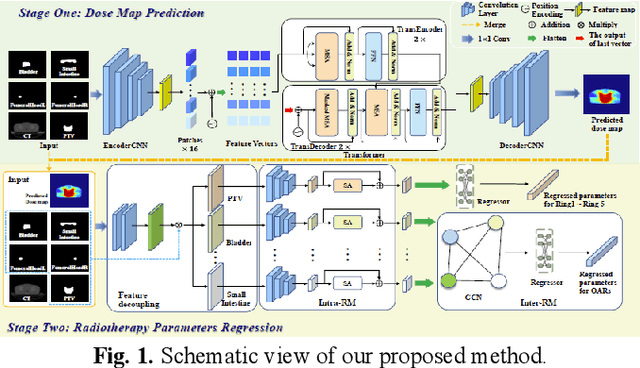
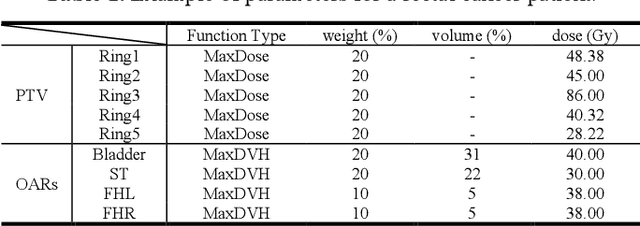
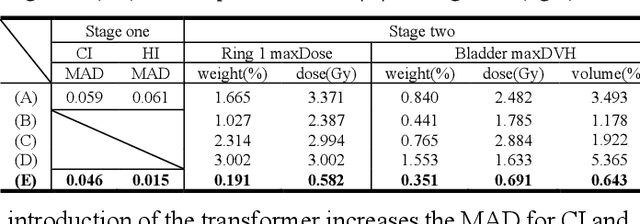

Abstract:Deep learning has facilitated the automation of radiotherapy by predicting accurate dose distribution maps. However, existing methods fail to derive the desirable radiotherapy parameters that can be directly input into the treatment planning system (TPS), impeding the full automation of radiotherapy. To enable more thorough automatic radiotherapy, in this paper, we propose a novel two-stage framework to directly regress the radiotherapy parameters, including a dose map prediction stage and a radiotherapy parameters regression stage. In stage one, we combine transformer and convolutional neural network (CNN) to predict realistic dose maps with rich global and local information, providing accurate dosimetric knowledge for the subsequent parameters regression. In stage two, two elaborate modules, i.e., an intra-relation modeling (Intra-RM) module and an inter-relation modeling (Inter-RM) module, are designed to exploit the organ-specific and organ-shared features for precise parameters regression. Experimental results on a rectal cancer dataset demonstrate the effectiveness of our method.
Deep Learning based Multi-modal Computing with Feature Disentanglement for MRI Image Synthesis
May 06, 2021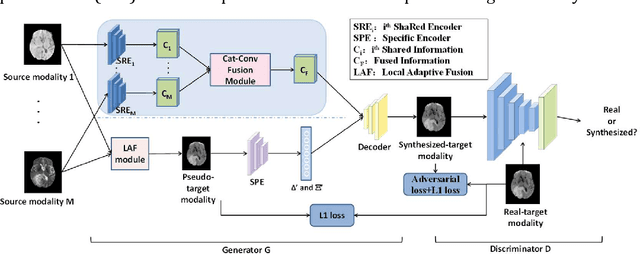

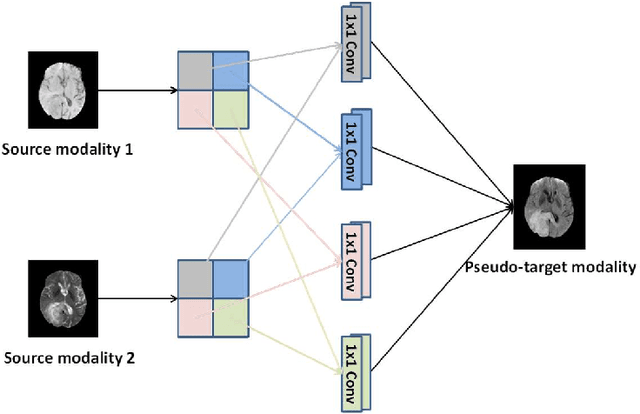

Abstract:Purpose: Different Magnetic resonance imaging (MRI) modalities of the same anatomical structure are required to present different pathological information from the physical level for diagnostic needs. However, it is often difficult to obtain full-sequence MRI images of patients owing to limitations such as time consumption and high cost. The purpose of this work is to develop an algorithm for target MRI sequences prediction with high accuracy, and provide more information for clinical diagnosis. Methods: We propose a deep learning based multi-modal computing model for MRI synthesis with feature disentanglement strategy. To take full advantage of the complementary information provided by different modalities, multi-modal MRI sequences are utilized as input. Notably, the proposed approach decomposes each input modality into modality-invariant space with shared information and modality-specific space with specific information, so that features are extracted separately to effectively process the input data. Subsequently, both of them are fused through the adaptive instance normalization (AdaIN) layer in the decoder. In addition, to address the lack of specific information of the target modality in the test phase, a local adaptive fusion (LAF) module is adopted to generate a modality-like pseudo-target with specific information similar to the ground truth. Results: To evaluate the synthesis performance, we verify our method on the BRATS2015 dataset of 164 subjects. The experimental results demonstrate our approach significantly outperforms the benchmark method and other state-of-the-art medical image synthesis methods in both quantitative and qualitative measures. Compared with the pix2pixGANs method, the PSNR improves from 23.68 to 24.8. Conclusion: The proposed method could be effective in prediction of target MRI sequences, and useful for clinical diagnosis and treatment.
 Add to Chrome
Add to Chrome Add to Firefox
Add to Firefox Add to Edge
Add to Edge